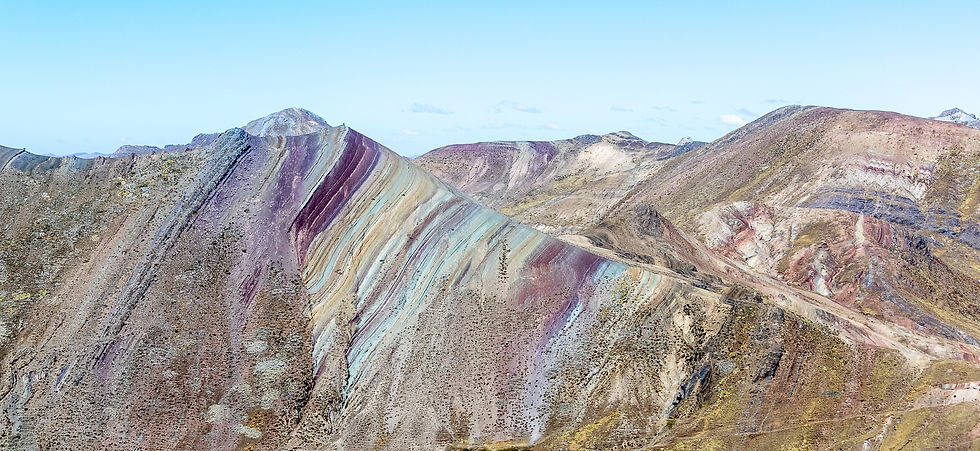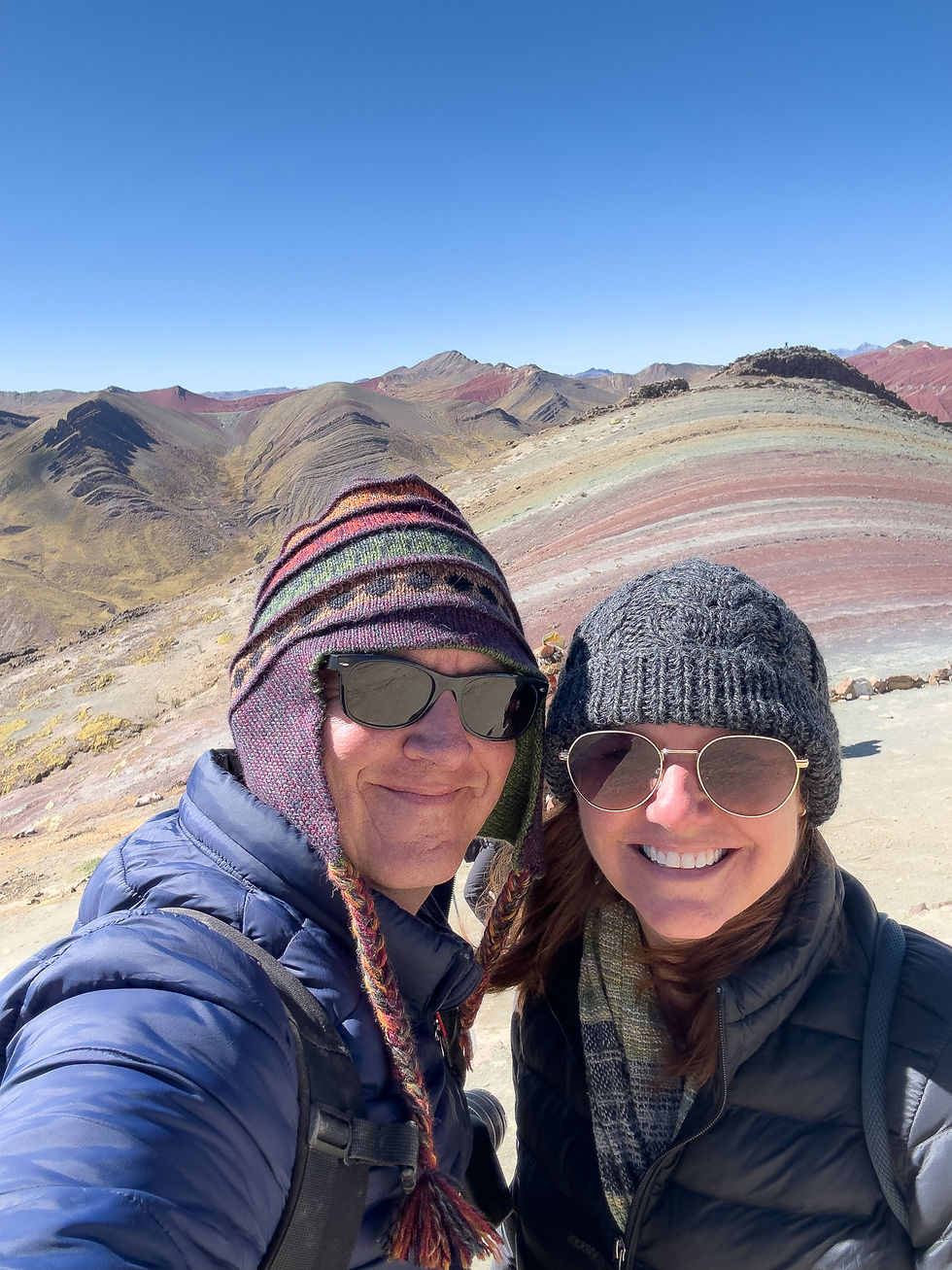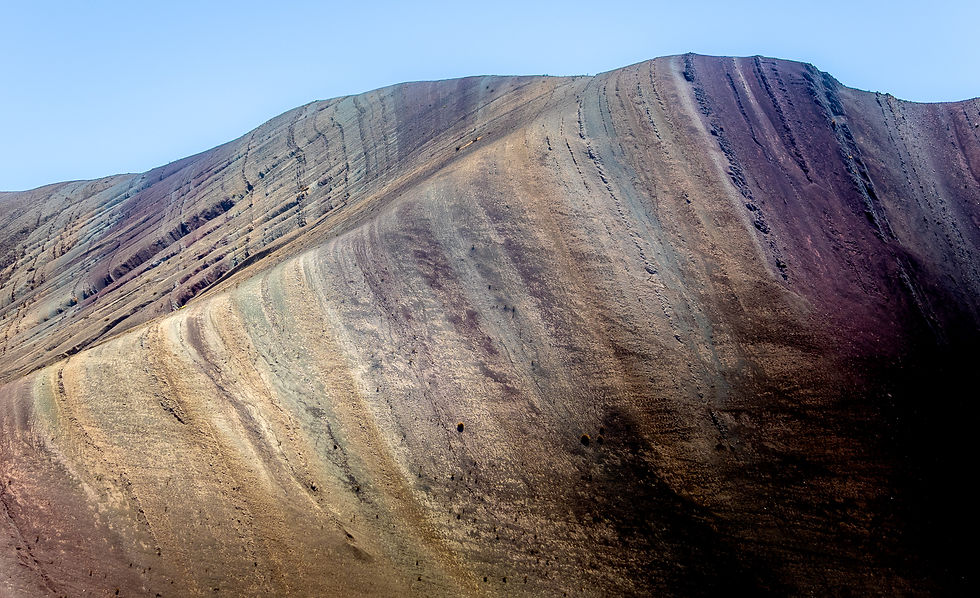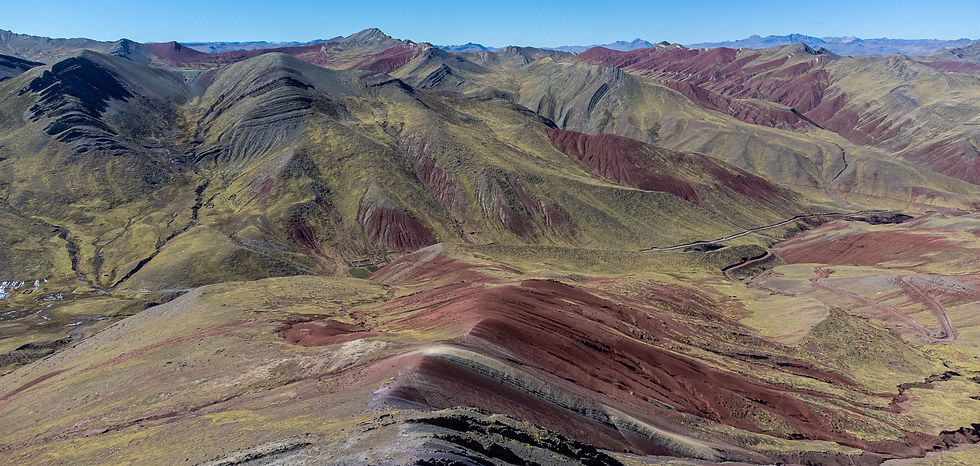Hiking Rainbow Mountain: What You Need to Know Before You Go
- Rand Blimes

- Jun 19
- 8 min read

Setting the Record Straight: There’s More Than One Rainbow Mountain
If you’re planning a day trip from Cusco to see Peru’s famous Rainbow Mountain, here’s something you should know: there’s not just one Rainbow Mountain anymore. There are two.
For years, the star of the show was Vinicunca—that dramatic, high-altitude, social-media darling with bold stripes of red, yellow, and turquoise. It’s the Rainbow Mountain you’ve probably seen in guidebooks and on Instagram. But it’s no longer the only option.
Enter Palccoyo.
Palccoyo is a newer addition to the tourist circuit, and there’s a reason it came into the spotlight more recently: it used to be buried under snow. Locals say the vibrant mineral layers were hidden until relatively recently, when climate change melted back the year-round snowpack, revealing a landscape just as striking as Vinicunca—if not more so.
As Vinicunca became overrun with crowds and the effects of altitude began sending a steady stream of tourists back down the trail in various states of nausea, Palccoyo quietly offered an alternative. It’s lower in elevation, easier to hike, and features three rainbow-striped mountains instead of one. It's also far less crowded—at least for now.
So no, “Rainbow Mountain” isn’t a single, one-of-a-kind location anymore. It’s a category. A brand. And thanks to global warming, that brand is expanding.
The good news? You’ve got options.
The bad news? Climate change is what gave you that choice.

Now Let’s Talk About Those Photos
Here’s the second thing you need to know before hiking Rainbow Mountain: the photos you’ve seen online—especially of Vinicunca—have been edited. Sometimes heavily.
It’s not that the colors are fake. The mineral stripes are real. But let’s just say that some people get a little too enthusiastic with the saturation slider. If the mountain in your imagination looks like a psychedelic art project painted by an over-caffeinated kindergarten class, you’re probably going to feel a little let down when you see it in real life.
And that’s a shame—because it is beautiful.
The problem isn’t the mountain. The problem is expectations.
The real colors are more subtle. Earthy reds, soft yellows, hints of green and lavender. Striking? Yes. Just not quite neon. If you go in expecting an unfiltered connection with nature—rather than a live-action postcard—you’re more likely to be impressed than disappointed.
So do yourself a favor: manage your expectations, not your Lightroom presets. Go in looking for a landscape that’s rugged, unusual, and shaped by time and tectonics—not one shaped by Instagram’s “vivid” filter. You’ll enjoy it a whole lot more that way.
See the epilogue at the end of this post for notes on how these images were processed.

Vinicunca vs. Palccoyo: Which Rainbow Mountain Should You Choose?
So you’ve got two Rainbow Mountains. Which one should you hike?
Here’s the short answer: it depends on what kind of experience you’re looking for—and how your lungs and legs handle hiking at high altitude.
Vinicunca
This is the classic Rainbow Mountain. The one you’ve seen in 10,000 pictures: that sharply ridged, boldly striped slope rising dramatically behind beaming hikers. If you want the iconic hero shot, this is the place.
But it’s not easy.
The hike is longer (about seven kilometers, compared to Palccoyo's four), and the trail is higher (you’ll top out around 5,200 meters—about 130 meters higher than Palccoyo). For some, that elevation bump doesn’t matter. For others, it absolutely does.
Vinicunca is also the more crowded of the two. If you don’t mind the city-in-the-sky approach to high altitude hiking, you will be fine. But know that you will be sharing the trail with many others, and you may even need to stand for a while in a queue to get that final hero shot.
This is a hike that requires effort, acclimatization, and a tolerance for crowds.
Still, if you’re up for a physical challenge, don’t mind broadly sharing a view, and want the shot, Vinicunca delivers.

Palccoyo
Palccoyo is the lower-key, easier-going alternative. The trail is a short loop, mostly smooth and not overly steep (apart from a short initial climb). You’ll still feel the altitude—this is Peru, after all—but it’s far more manageable for anyone who isn’t loving thin air.
For us, it was an easy decision. We picked Palccoyo because my wife had been struggling with altitude on our hikes out of Huaraz. She took it slow, and did just fine. No headaches. No regrets.
The payoff is different here. The main rainbow section doesn’t rise behind you quite as dramatically as at Vinicunca, so the famous photo-op moment may feel a little less cinematic. But what Palccoyo lacks in single-shot drama, it makes up for in overall scenery. You’re surrounded by rolling, striped ridges. Three separate rainbow mountains dot the horizon. It’s quietly spectacular.
And while you won’t be all alone on this hike, you will share it with far fewer people than you will on Vinicunca.

Hiking Rainbow Mountain: Which Should You Choose?
If you want the iconic Instagram shot, and your lungs (and knees) can handle the altitude, go with Vinicunca.

If you’d prefer a more relaxed experience with panoramic views and fewer people, Palccoyo is your mountain.
Either way, you’ll earn your rainbow.
Just be sure to catch your breath while you’re at it.
How to Book a Rainbow Mountain Tour
Booking a day trip to either Rainbow Mountain is easy—especially if you’re already in Cusco.
We visited in high season and didn’t book more than a day in advance. We had no problem at all. We just wandered around Cusco’s Plaza de Armas, where nearly every other door seems to be a tour agency. Most packages were more or less the same: early morning departure, transportation, guide, breakfast, lunch, and plenty of time at the mountain.
So we picked the agency with the friendliest staff and booked on the spot. Done.
If you prefer to lock things in ahead of time—especially if you're traveling during a tight itinerary or prefer having everything settled—platforms like GetYourGuide or Viator offer plenty of options. When we checked, the online prices were just a bit higher than what we paid in person, but still reasonable. For some travelers, that small markup is worth the peace of mind.

A few tips:
Ask if breakfast and lunch are included. They usually are, but it’s good to confirm.
Check what the hike involves. Some agents will book you for Vinicunca when you wanted Palccoyo (or vice versa), so make sure the name is right.
Bring cash. Many agencies accept cards, but cash may get you a better deal—or a smoother transaction.
Bottom line: you don’t need to stress about booking this ahead of time. But if you like having your ducks in a row, you’ve got options. Either way, you’ll be leaving Cusco early, seeing something wild, and getting home in time for dinner.

A Word About Altitude Sickness
No matter which Rainbow Mountain you choose—Vinicunca or Palccoyo—you’re going to be hiking at altitude. Serious altitude. Vinicunca tops out around 5,200 meters, and Palccoyo isn’t far behind. That means altitude sickness isn’t just a remote possibility—it’s something you need to be ready for.
There’s a wide range of symptoms, and not all of them mean you need to panic. Most people experience some level of discomfort:
Headaches
Nausea
Shortness of breath
Lightheadedness
Fatigue
Lack of appetite
Annoying? Yes. Dangerous? Not usually.
But there’s a line. And it’s important to know where that line is.
If you—or someone in your group—starts showing signs of serious altitude sickness, that’s not something you can just walk off. The only real treatment is descending. Immediately. Watch for:
Confusion or slurred speech
Loss of coordination or balance
Shortness of breath at rest
Tightness in the chest
Vomiting that doesn’t stop
A terrible dry cough that just gets worse and worse
These symptoms may indicateserious high-altitude cerebral or pulmonary edema (HACE or HAPE), and they’re rare—but very real. Don’t try to push through. Get to lower ground. Fast.
The best way to avoid this is to give yourself some time to acclimate to the altitude before trying a high mountain hike. Spend a few days in Cusco if you are coming from near sea level.

If you want a little extra insurance, Diamox (acetazolamide) is widely available at pharmacies in Cusco. No prescription needed. It doesn’t eliminate altitude sickness, but it can help reduce symptoms and ease the adjustment. Talk to your doctor before taking it—or consult a pharmacist locally if you’re unsure.
Best strategy?
Take time to acclimate. Take it slow. Stay hydrated. Listen to your body.
Most travelers will feel at least a little off at this altitude—but with good prep and a dose of humility, you can manage it just fine.

Final Thoughts on Rainbow Mountain
Rainbow Mountain may not look exactly like the filtered photos online, and your hike might not feel exactly like the highlight reel someone posted on Instagram. But that’s OK.
It’s high. It’s hard. It’s beautiful in a way that’s quietly earned—not handed to you in postcard form. Whether you choose Vinicunca or Palccoyo, you’ll walk away with something more than just a photo. You’ll have seen something rare, raw, and still changing—revealed by time, tectonics, and yes, even climate change.
And if you’re lucky, you’ll feel that quiet satisfaction that comes when the air is thin, the scenery wide, and your legs a little tired.
Because travel isn’t just about going—it’s about earning your new experiences.
Epilogue: A Word About the Photos
Given that this post addresses the problem of over-processed images creating unrealistic expectations, I want to be transparent about how the photos in this post were created.
All the images you see here were taken by me using one of three cameras: a Canon R6, an iPhone Pro, or a DJI Mini drone. I shot everything in RAW format to allow for proper exposure recovery and subtle adjustments. The drone, for its part, captured bracketed exposures—three images per shutter press—which I combined into HDRs to bring out detail in both the skies and shadows.
All photos were edited in Lightroom. Most of my post-processing work focused on exposure: I pulled the highlights down and pushed the shadows up, then fine-tuned the whites and blacks to create a balanced histogram. I rarely touch the saturation slider—and when I do, it’s never more than a subtle bump (no image in this post goes beyond +5 saturation—a very small adjustment in Lightroom).
In a few of the shots, I actually reduced the yellow saturation (typically by -5 to -7) to emphasize the reds and oranges in the landscape. I did not change the hue of any color in any of the images.
I also changed exposure on specific subjects (ex: I increased the exposure slightly on the llama to bring attention to it), and I removed some distracting objects. There were other tweaks here and there, but this is the full story in terms of bringing out colors.



Comments